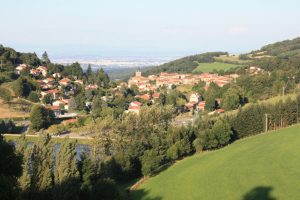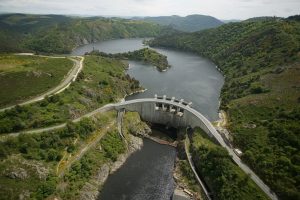The is the second part of the story about Joan’s travel to Lyon
After two or three days of complete peace, we felt we should venture further afield, so off we went to Lyon, to hire a car. We had found out before we left England, that S.N.C.F. was one of the cheapest and easiest to hire from, and we had checked with the Controller in Paris that as long as Neil was next to him, Peter could drive the car: the worry had been that no-one under 21 yrs. could hire a car, and Peter was still only 19, though he had passed his test at 17 yrs. and had plenty of driving experience.
Luckily, we had the Controller’s ruling in writing, because when the form was filled in at Perrache Station, the lady clerk was very definite that the car could not be insured for Peter driving. A very long and heated argument began. I soon gave up trying to understand what was going on, and I was most impressed by Peter’s command of the language (Neil did quite well too!). Finally, the lady, who seemed to doubt our letter, rang the Paris office, and all was well. We found our car in the line of hire cars, usually to be found outside French stations, and we went!
Traffic in Lyon is always at rush-hour quantity and pace, and there is a one-way system, which always seems to take you in the opposite direction from the one you wish to go. We needed to cross the bridge over the River Saône for our journey back to Vaugneray, but somehow, try as we might, we just could not get into the correct stream; we kept coming back to the same corner from which we had set out. We sat in the car and watched how the bus did it, then followed -SUCCESS, at last! After that, it was plain sailing back to Vaugneray, where our arrival caused a flutter amongst the old ladies.
 |
| Yzeron |
We had been told, in the Tourist Office, that we must visit a little village called Yzeron, which was not very far from Vaugneray, so we made this our first port of call. It lived up to its reputation: it is at the top of a hill, surrounded by other hills, but with views far across the Lyonnaise countryside. It looked very picturesque with old houses covered in wall paintings, and there were flowers everywhere. There was a wedding at the little church, and the bridal procession through the main street was a colourful sight. Yzeron should be on every tourist’s map, but would soon lose its old-world charm if it were. To our astonishment, in the middle of this little hidden paradise, there was a telephone box, and Peter rang Loughborough to check on his first- year exam results-all was well! The call went through without a hitch, and we pondered on how France is a strange mixture of ancient and modern.
 |
| La Ferme Bonnet |
 |
| St. Martin en Haut |
Another delightful place in this area was Le Col de la Luere, a vantage point from which one could see for miles in the Lyon direction. Quite near here, we found La Ferme Bonnet, a group of very old buildings, including a chapel; there was an extremely pretty terrace and courtyard, where we were able to sit down and enjoy some ice-cream and coffee. A few kilometres in the opposite direction, was St. Martin en Haut, a very small town perched on a plateau amongst the hills; it had the same sleepy old-world charm of Yzeron, and the same characters seemed to be sitting sipping their beer outside the bars.
The day we decided (hopefully) to trace the River Loire to its source, we set out very early. Mme. Midey insisted that we should take a packed lunch, and what a feast it was! There was so much that we had to lose some on the way home, in case we offended by not eating everything. We took the road leading towards Montbrison, then turned south down the river valley at Montrond les Bains; this rather grandly named place was a bit of a disappointment, as was most of the wide flat lands that lay on each side of the now quite narrow River Loire.
 |
| Barrage de Grangret |
As we approached the Barrage de Grangent, the countryside, on both sides of our route, suddenly changed into rolling hills, with mountains beyond. The barrage, which is part of a huge hydro-electric scheme, makes a large lake to the south, on which a pleasure beach has been created. It was rather unexpected to see the umbrellas, boats and other sea-side paraphernalia, more usually associated with the Mediterranean coast. We saw it first from on high, and thought it might be worth a visit, but, on closer inspection, we decided to give it a miss, but not before we had stopped to admire the village lying behind the beach. It was obviously a show piece, well-known to the French-each street was lined with flower-beds filled with blooms, from the humble nasturtium to the really exotic. Notices told us that the village had won a national award for its efforts.
From here we took the road to St. Etienne, a rather ugly industrial town, then on to the autoroute which joined the Autoroute du Soleil just north of Vienne-this led us back to Lyon. Unfortunately, we missed our exit for Vaugneray, and found ourselves speeding through Lyon, and it was some time before we were able to leave at the next junction. We found ourselves in completely unknown territory, and to make it worse, it was now the height of the Friday afternoon rush hour! We evoked the wrath of a traffic policeman, who blew his whistle loudly, and gesticulated furiously! Luckily, Peter, who was driving, took the whole matter very calmly, and we eventually extricated ourselves, and returned to our bridge over the Saône.
This should have led us up the hair-pin road towards home, but somehow we took the wrong turning once more, and entered a long tunnel full of choking traffic fumes; of course we had to wait until we were through, before turning to come back again the same way. We arrived back late for supper that day, but were greeted with obvious delight that we were safe, and our meal was served up to us immediately, with many questions about our adventures.
There was quite a flutter on the day of our leaving Vaugneray; there were many questions concerning our route and mode of travel. We went round all the guests to say “au revoir”, and our hands were shaken over and over again. Our greatest surprise was the little old gentleman, who, hearing that we were off to London, began to sing “It’s a long way to Tipperary”; he sang two full verses in English, certainly more than we knew of the song, and we asked him how he knew it, as he didn’t speak any other English. The reason was simple-he had hidden two British airmen in his house during the war, and they had taught him! It was our turn to shake his hand, and I felt sad that I had laughed at this comical old man, who had risked his life so.
The Midey family lined up at the bus stop with us (we had returned our car by now), and when the bus arrived, ‘Patron’ leapt inside with our luggage, making sure that we were comfortable; the bus was further delayed as we shook hands and embraced, and as we gave a final wave, we swore to return one day—–but that is another story!
A final note: This was my first visit to rural France, and for the first time, I learned that the people of other countries are just as bad as the British about learning another language. No-one we met outside Lyon spoke or understood a word of English.
All Images are from Google.com




